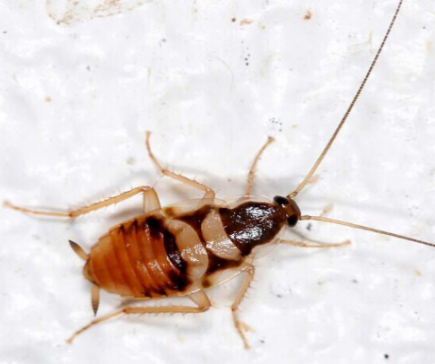Cockroaches
(Photo credit to Gary Alpert, Harvard University, Bugwood.org)
American cockroach (Periplaneta americana)
(Photo credit to Gary Alpert, Harvard University, Bugwood.org)
(Photo credit to Gary Alpert, Harvard University, Bugwood.org)
German cockroach (Blattella germanica)
(Photo credit to Len Worthington)
Pacific beetle cockroach (Diploptera punctata)
(Photo credit to Len Worthington)
(Photo credit to Len Worthington)
Harlequin cockroach (Neostylopyga rhombifolia)
(Photo credit to Gary Alpert, Harvard University, Bugwood.org)
Brown-banded cockroach (Supella longipalpa)
(Photo credit to Gary Alpert, Harvard University, Bugwood.org)
Surinam cockroach (Pycnoscelus surinamensis)
Prevention of Cockroaches
Effective control of cockroaches at home highly relies on sanitation and hygiene that reduce the food and shelter for the cockroaches. Some of the non-chemical practices are listed below:
- Clean up the food-handling area immediately and regularly. Dishes and utensils in the sink area should not be left unwashed overnight.
- Water availability should be reduced. Water dipping or leaking should be checked regularly.
- Remove trash from your home daily or stored in tightly closed containers.
- Routinely sweep and mop the kitchen and pantry area.
- Store food and drinks in sealed containers.
- Cracks and crevices should be sealed to avoid harborage of cockroaches.
Control of Cockroaches
There are several chemical controls used in controlling cockroaches such as surface sprays, space sprays, dusts, baits, and traps. Read carefully and follow the instructions on the label before applying any chemical treatment. It is advisable to consult pest control professionals if you found cockroaches in your home. A proper species identification and an inspection on the level of infestation followed by the appropriate treatment is important in cockroach management.
References
- Urban Insects and Arachnids: A Handbook of Urban Entomology (2005). William H Robinson. Cambridge University Press.
- Urban Pest Control in Australia (1985). P Hadlington and J Gerozisis. New South Wales University Press.
- NPMA Field Guide to Structural Pests, Second Edition (2007). Eric H. Smith and Richard C. Whitman.
If you require information in an Alternative format, please contact us at: jwtay@hawaii.edu






